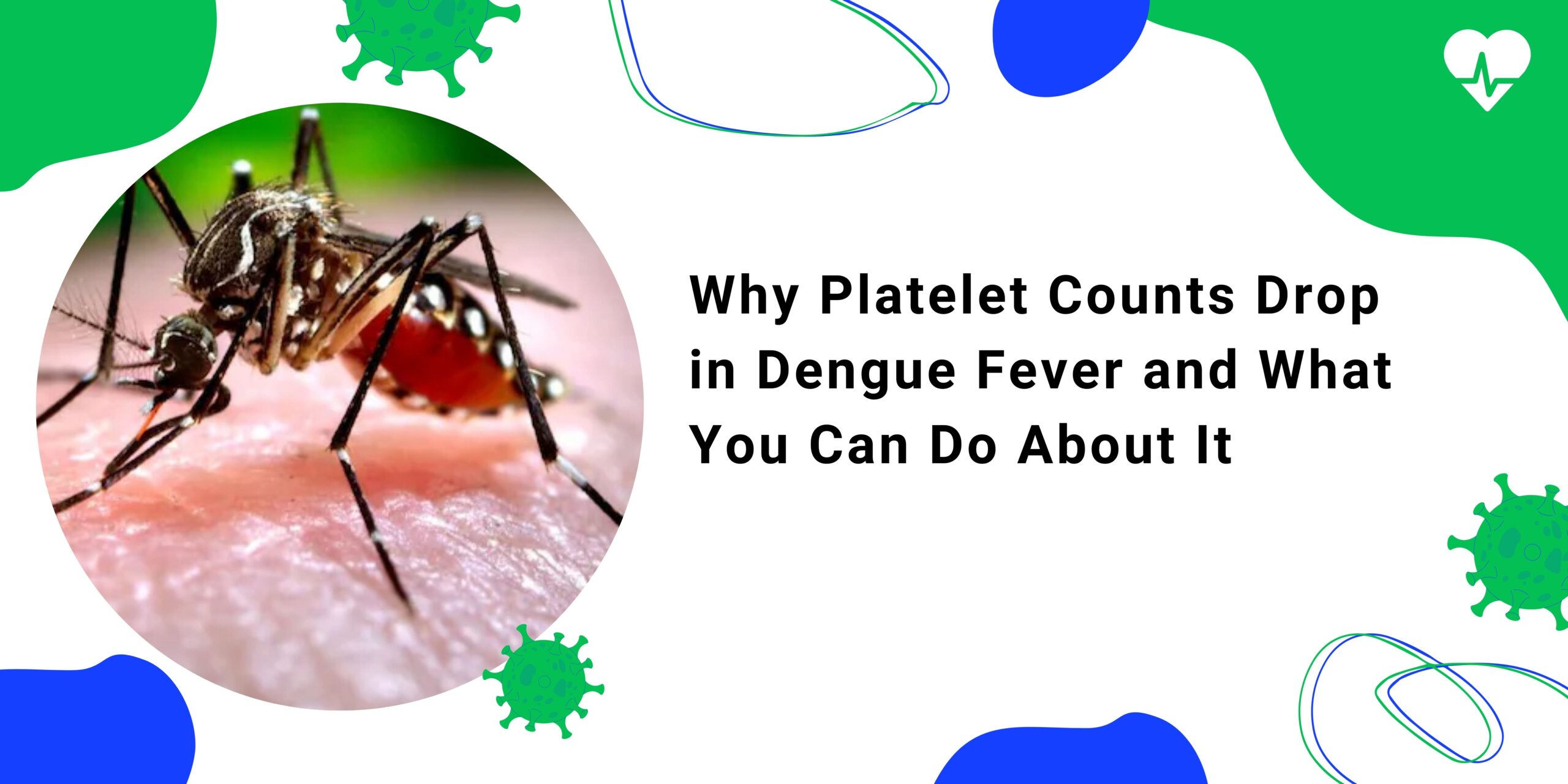Subtotal $0.00
Dengue fever is a significant global health concern, mainly in tropical and subtropical regions. A serious aspect of dengue fever that often panics patients and healthcare providers alike is the drop in platelet counts. Understanding why this happens and what can be done about it is crucial for effective management and recovery.
What is Dengue Fever?
Dengue fever is a mosquito-borne viral infection caused by the dengue virus, which is spread by Aedes mosquitoes, It primarily affects people in tropical and subtropical regions, including parts of Asia, the Americas, and Africa.
Symptoms of Dengue Fever
First symptoms of dengue fever include high fever, severe headache, pain behind the eyes, joint and muscle pain, and rash. In severe cases, it can lead to dengue hemorrhagic fever or dengue shock syndrome, which are potentially fatal.
Understanding Platelet
Platelets, also known as thrombocytes, are small cell fragments in the blood that play a vital role in blood clotting. They help stop bleeding by clumping and forming plugs in blood vessel injuries.
Why Platelet Counts Drop in Dengue Fever
Platelet counts drop in dengue fever due to several interconnected devices:
1. Immune System Response
– The immune system reacts aggressively to the dengue virus, occasionally leading to the destruction of platelets.
2. Bone Marrow Suppression
– The virus can suppress bone marrow function, dropping the production of platelets.
3. Increased Destruction of Platelets
– The virus may increase the destruction of platelets in the liver and spleen.
4. Dilution Effect
– Fluid outflow from blood vessels can dilute the concentration of platelets in the blood.
The Immune System’s Role
When the body is diseased with the dengue virus, the immune system responds by creating antibodies. In some cases, these antibodies can enhance the virus’s capability to infect more cells, a phenomenon known as antibody-dependent enhancement, which can exacerbate the reduction of platelet counts.
Bone Marrow Suppression in Dengue
The dengue virus can infiltrate the bone marrow, the site of platelet production. This attack can lead to bone marrow suppression, significantly decreasing platelet production and contributing to thrombocytopenia
Destruction of Platelets
The liver and spleen play roles in cleaning and destroying infected platelets. During a dengue infection, these organs can become overactive, leading to an improved breakdown of platelets.
Dilution Effect
Severe dengue can cause plasma leakage from blood vessels, leading to hemoconcentration. This results in a relative dilution of platelet counts in the bloodstream, contributing to thrombocytopenia.
Symptoms of Low Platelet Count
Common symptoms of a low platelet count (thrombocytopenia) include easy bruising, prolonged bleeding from cuts, petechiae (small red spots on the skin), and bleeding gums. Severe thrombocytopenia can lead to internal bleeding, which is a medical emergency.
Diagnosing Low Platelet Count in Dengue
Medical professionals diagnose low platelet counts through blood tests, including complete blood count (CBC) and platelet count. Early detection is essential for monitoring and managing the condition effectively.
Managing Low Platelet Counts
Managing low platelet counts involves a grouping of medical treatments and supportive care at home.
Medical Treatments for Low Platelet Counts
In severe cases, medical interventions such as platelet transfusions, corticosteroids, and intravenous immunoglobulins (IVIG) may be necessary. Hospitalization might be required for close monitoring and supportive care.
Home Remedies and Supportive Care
1. Hydration and Nutrition
– Drink plenty of fluids to stay hydrated and maintain blood volume.
– Consume a balanced diet rich in vitamins and minerals to support overall health and recovery.
2. Rest and Monitoring
– Get ample rest to allow the body to fight off the infection.
– Regularly monitor platelet counts as advised by healthcare providers.
Prevention of Dengue Fever
Preventing dengue primarily involves avoiding mosquito bites. Use insect repellent, wear protective clothing, and ensure that your living environment is free from standing water where mosquitoes breed. Community and government efforts play a significant role in controlling mosquito populations and reducing the incidence of dengue fever.
Conclusion
Understanding why platelet counts drop in dengue fever and knowing how to manage this condition can significantly improve outcomes for those affected. Prevention remains the best strategy, but awareness and prompt medical attention are crucial for those who contract the virus. Meeting the Best General Physion nerme
FAQ
A standard platelet count ranges from 150,000 to 450,000 platelets per microliter of blood.
Platelet counts typically begin to recover within a few days to a week after the fever subsides, but full recovery may take several weeks.
Yes, severe cases of dengue fever, particularly dengue hemorrhagic fever and dengue shock syndrome, can be fatal if not promptly and properly treated.
Yes, vaccines such as Dengvaxia are available, but their use is subject to certain conditions and they are recommended primarily for people who have had a previous dengue infection.
If you suspect dengue fever, seek medical attention immediately. Early diagnosis and treatment are essential to manage symptoms and prevent complications.




Https://jeevikahospital.in/why-platelet-counts-...
August 1, 2024[…] Discover why platelet counts drop in dengue fever and learn effective strategies to manage and prevent this condition. […]